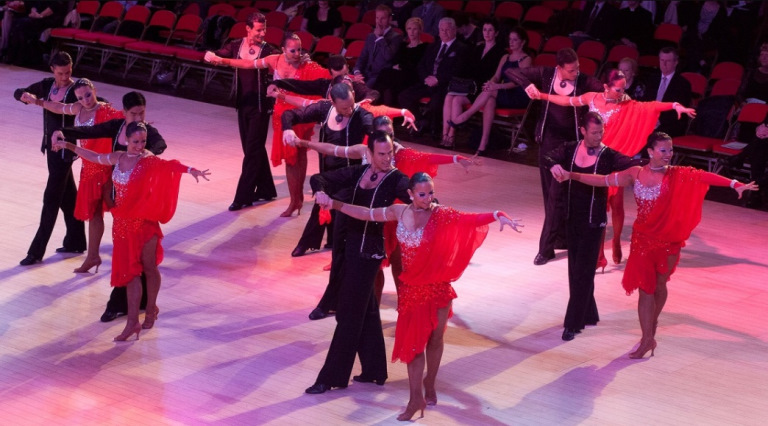Table of Contents
Formation Dance History
If you are interested in ballroom dancing, you might encounter the Formation style from time to time. It consists of couples dancing in patterns or as shadow teams, either for exhibition or competition.
Depending on the purpose, the choreographer might base it on one specific dance or combine a medley.
The first time Formation appeared was recorded in 1932, from the Astoria Ballroom in London. During that initial era, people referred to it as “pattern dancing”.
Along with the acceptance it got, more contests for Formation teams were organized and the style reached foreign countries as well.
In the 1960s, its popularity reached its peak with international competitions.
Formation Dance Choreography
The professional choreography of Formation dance includes dancesport moves for each individual and the joined pattern of the couple. Of course, they need to follow the beats while executing the movements precisely.
Aside from performing well as an individual and in a duo, the dancers must move with their team. Hence, the “chain reaction” trick is very common in Formation.
In Ballroom or Standard Formation, we have 5 Ballroom dance styles: Waltz, Tango, Quickstep, Foxtrot, and Viennese Waltz.
In Latin Formation, we have 5 Latin dance styles: Rumba, Paso Doble, Samba, Jive, and Cha Cha.
The teams are allowed and encouraged to create shapes during their performance, such as diamonds, circles, diagonals, and more.
If the transitions are smooth and patterns are visible, the judges might give them bonus points.
The routine might incorporate jazz or ballet techniques for free-form moves as the dancers walk on and walk off. The audience can detect them with the gongs.
Check more: What Is The Cariñosa Dance?
Rules in Formation Dance Contests
The body governing the international contests of Formation dance is IDSF (International Dancesport Federation).
The participating teams must be part of IDSF’s member organizations and follow the rules:
- There can be two teams from each member country for each category (Standard or Latin). These teams are qualified by national contests.
- An international contest has at least 4 countries taking part in it. Each team contains 6 – 8 pairs.
- The dancers must be amateurs.
- Everyone must follow the anti-doping rules.
- Standard male dancers must wear midnight blue or black costumes. Latin male dancers may wear shirts of different colors but must dress the same.
- Solo routines are 8 bars in Standard and unlimited in Latin.
- The main performance cannot include lifts, though the walk-on and walk-off may use lifts.
- The teams have 6 minutes max to get on and off the stage, and 4 and a half minutes are evaluated and judged.
